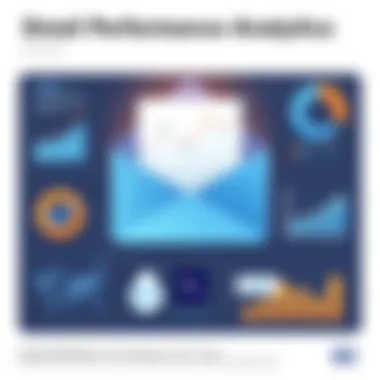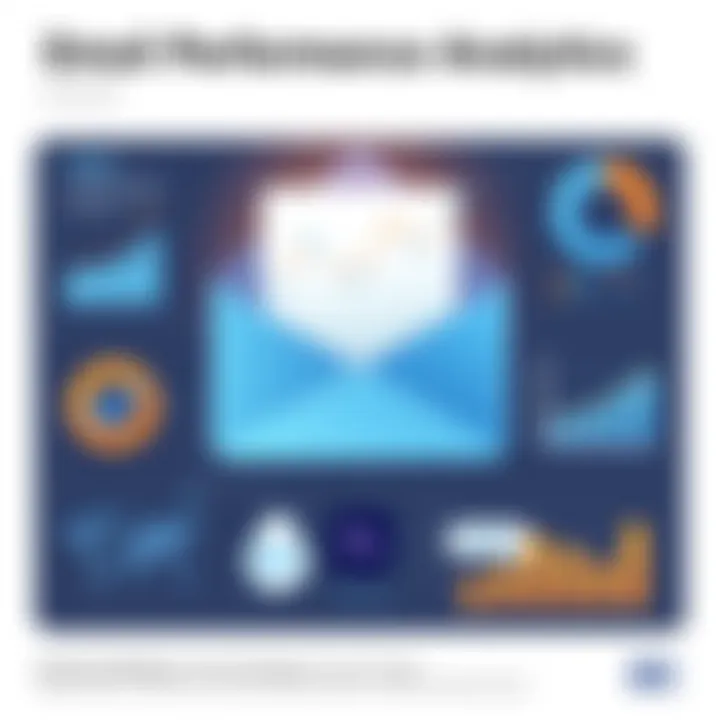Enhancing Email Marketing: Advanced Strategies for Success


Intro
In the digital landscape, email marketing stands as a stalwart method for businesses aiming to nurture customer relationships and drive conversions. However, to truly harness its power, marketers must move beyond the basics and explore advanced techniques that can enhance their email strategy. This article focuses on innovative approaches that leverage audience insights and technological advancements, pointing towards a more effective email marketing framework.
Marketers often find themselves navigating a complex web of consumer preferences and behaviors. To stay ahead, it's essential to understand these demographics intimately. Through data-driven insights, businesses can craft targeted campaigns that resonate with their audience. By dividing potential customers into specific segments, marketers can personalize content and deliver it through the right channels, paving the way for improved engagement. In essence, the goal is to cultivate a relationship with the consumer, one email at a time.
As we embark on this exploration, we’ll delve into various strategies such as audience segmentation, content personalization, A/B testing for optimizing campaigns, and performance analytics to monitor success. Each of these elements will play a pivotal role in refining your email marketing efforts to not just meet but exceed expectations of open and conversion rates.
Software Overview
In today's ever-evolving market, several platforms have emerged to support email marketing strategies. Selecting the right software is crucial as it significantly impacts how effectively a campaign can be executed. Choosing the right tool allows marketers to automate processes, analyze outcomes, and tailor approaches to meet their specific needs.
Software Description
Leading email marketing platforms, like Mailchimp or SendinBlue, offer extensive functionalities to keep up with the dynamic demands of email marketing. These tools support the entire lifecycle of a campaign—thinking from planning and creation, through execution, and finally tackling performance insights.
Key Features
- Audience Segmentation:
This feature allows marketers to divide their contact lists based on various criteria such as age, location, or buying behavior. - Content Personalization:
Through variable data options, businesses can send tailored messages that reflect the recipient's interests. - A/B Testing:
This allows users to test different subject lines or content formats to determine which resonates best with their audience, thus improving overall engagement. - Analytics & Reporting:
Comprehensive reporting tools that track open rates, click-through rates, and overall campaign performance make it easier for marketers to assess their campaign success.
User Experience
An effective email marketing strategy does not hinge solely on backend capabilities; the user experience plays a critical role as well. Marketers need software that is not only powerful but intuitive to use, streamlining the campaign management process.
User Interface and Design
The interface of email marketing software should be user-friendly, enabling even those without advanced technical skills to create compelling emails. Clear navigation and well-organized options promote a smoother workflow, ensuring that marketers can focus on crafting quality content rather than wrestling with tools.
Performance and Reliability
Lastly, the performance of the email software is non-negotiable. It should guarantee the timely delivery of emails, minimizing bounce rates, and ensuring that content lands in the inbox rather than the spam folder. Reliable platforms are built on solid technology that supports high throughput and fast processing, which in turn fosters better relationships with recipients due to consistent and timely communications.
Effective email marketing is not just about sending messages; it’s about sending the right message to the right person at the right time.
As we dive deeper into the various strategies for enhancing email marketing effectiveness, it becomes clear that leveraging technology while maintaining a clear focus on your audience's needs can significantly boost the ROI of your campaigns.
Understanding the Basics of Email Marketing
Email marketing remains a cornerstone of successful digital strategies, vital for both small and large businesses alike. Understanding the foundations of email marketing helps professionals appreciate its nuances, capitalize on its strengths, and avoid common pitfalls. The ability to effectively communicate via email allows for a direct line to customers, fostering relationships and driving engagement.
In a world where consumers are bombarded with information from all directions, email marketing offers a personal touch. It allows businesses to reach out directly to their audience in a way that can feel customized and inviting. However, it's essential to grasp the basic principles that guide this form of communication to harness its full potential.
Defining Email Marketing
Email marketing is the process of sending commercial messages, typically to a group of people, utilizing email. These messages can vary widely in purpose—from newsletters that keep customers informed about new products to promotional offers designed to entice purchases. The heart of email marketing lies in its capacity to build relationships through consistent communication, which is much more efficient and cost-effective than many other marketing forms.
Effective email marketing campaigns hinge on several pivotal elements:
- Target Audience: Knowing who receives your emails helps tailor content that resonates.
- Personalization: This involves addressing recipients by name or offering products based on previous interactions. A simple approach to highly personalize a messaging can lead to higher engagement rates.
- Call-to-Action (CTA): Every email should guide the reader toward a specific action—be it visiting a website, making a purchase, or following on social media.
- Performance Metrics: Monitoring open rates, click-through rates, and bounce rates gives insight into the effectiveness of your campaigns, allowing for continuous improvement.
Email Marketing vs. Other Marketing Channels
When comparing email marketing to other channels, several distinctions and benefits set it apart:
- Cost-Effectiveness: Email marketing often proves to be more cost-efficient compared to social media or paid ads. With a relatively low cost per email sent, businesses can achieve a high return on investment.
- Direct Communication: Unlike social media platforms where messages can get lost in feeds, emails land directly in inboxes and can be addressed personally.
- Measurement and Tracking: Email platforms often provide detailed analytics on how well messages perform. Metrics like open rates and click rates can indicate audience engagement more accurately than other channels.
In summary, understanding the basics of email marketing not only underscores its importance but also equips marketers with the information necessary to inform their strategies effectively. Setting the groundwork with solid definitions and comparisons lays the foundation for more advanced strategies discussed later in this article.
For additional resources on email marketing fundamentals, check out Wikipedia on Email Marketing or Britannica's comprehensive overview.
Importance of Email List Management
Managing an email list isn’t just a checkbox in your marketing plan; it’s the bedrock of success in email campaigns. When marketers emphasize Email List Management, they’re putting a spotlight on quality over quantity. A well-maintained subscriber list can help in creating targeted, relevant experiences, which ultimately result in higher engagement and conversions.
Building a Quality Subscriber List
To kick things off, creating a quality subscriber list is akin to laying the foundation for a strong building. You want people who are genuinely interested in what you have to say. One effective way to build this list is through sign-up incentives, like exclusive content or discounts. You can also utilize content marketing strategies to draw people in, using blog posts and landing pages that are rich in insight.


Another important aspect to consider is the proper use of double opt-ins. This can seem a bit tedious, but it ensures that the people on your list really want to be there. You’ll weed out the uninterested souls, resulting in a database filled with engaged users. In the long run, this pays off: higher open rates and better brand loyalty.
Segmenting Your Audience Effectively
Once you've got your subscribers in the door, segmentation is your next best friend. Splitting up your audience based on specific criteria can lead to exceptionally tailored content. When you speak directly to varied groups of people, they feel more valued and understood. This is where demographics, behavior, and psychographic information come into play.
Demographic Segmentation
Demographic segmentation breaks down your audience based on characteristics like age, gender, location, and income level. For instance, sending messages tailored to a 25-year-old in an urban area will differ vastly from a 50-year-old in a suburban neighborhood. This approach allows marketers to tap into unique motivations, which can lead to improved engagement.
One of the hallmarks of demographic segmentation is its ability to streamline content creation. Since you focus on specific groups, it becomes easier to align your messaging with their life stages or economic status, thus enhancing relevance. However, it can be a double-edged sword; over-segmenting might lead to fragmentation, making it hard to maintain a cohesive brand voice.
Behavioral Segmentation
Turning attention to behavioral segmentation, this approach targets users based on their interactions with your brand. Think engagement metrics: clicks, purchases, site visits, or even time spent on emails. Marketers utilize this approach to identify patterns that can inform future email campaigns.
One key feature of behavioral segmentation is its timeliness. By analyzing real-time data, marketers can react instantly to changing user preferences. For example, if a subscriber frequently clicks on sports-related content, it makes perfect sense to send them related offers. However, like most things, there’s a caveat; focusing solely on behavior may overlook other important factors that influence consumer decisions.
Psychographic Segmentation
Lastly, psychographic segmentation digs deeper by exploring the attitudes, interests, and lifestyles of your audience. This form of segmentation gets under the skin of your target market. It involves understanding not just who your audience is, but why they engage with your content. Factors like values, beliefs, and personality traits come into play here.
Using psychographic insights allows marketers to create campaigns that resonate on an emotional level. For instance, brands that align their messaging with a specific lifestyle or value can foster deeper connections. But be cautious; relying exclusively on this approach can lead to overlooking significant demographic trends that also shape buying behavior.
"The true art of email marketing lies not just in who gets your messages, but in how well you understand them."
For further reading, check resources like Mailchimp's Email Marketing Guide or Campaign Monitor's Guide to Email Segmentation to strengthen your strategy.
Crafting Engaging Email Content
Crafting engaging email content is more than just a tick-box exercise in your marketing strategy; it’s the backbone of effective communication with your audience. When done right, email content can pique the interest of recipients, prompting them to interact with your business in meaningful ways. This content should speak directly to readers, addressing their needs, pain points, and desires. The benefits of engaging email content extend beyond just improving open rates—it lays the groundwork for fostering trust and loyalty among subscribers.
Bringing value through well-structured emails isn’t a mere suggestion; it’s an expectation in today’s fast-paced digital environment. An increase in customer expectations means that your email content must consistently deliver not only relevant information but also resonate on an emotional level. This often requires a blend of strategies, making the crafting of email content both an art and a science.
The Role of Compelling Subject Lines
The subject line is your first line of defense in capturing user attention. It's akin to the cover of a book; if it doesn't resonate, the reader likely won't venture further. A compelling subject line should entice the reader to click on your email, making it one of the most vital components of your email strategy. Noteworthy examples might include leveraging curiosity or urgency: "Is Your Email Strategy as Effective as You Think?" or, "Last Chance: Exclusive Offers Just for You!" These small shifts in messaging can have outsized effects on open rates.
The effectiveness of subject lines can significantly impact your overall email performance. According to studies, nearly 33% of recipients open emails based solely on the subject line. In this way, investing time and creativity into this element is a no-brainer.
Personalization Techniques
Personalization in email marketing isn’t just about inserting a name into the greeting. It's about creating relevant and meaningful interactions tailor-made for individual recipients. Personalization helps build a bridge between the marketer and the subscriber. Two common personalization techniques that stand out are Dynamic Content Insertion and User Behavior-Based Personalization.
Dynamic Content Insertion
Dynamic Content Insertion allows you to customize the email message's various elements based on the subscriber's data. It’s incredibly versatile because it lets users see content specially tailored for their preferences or history. For instance, if a subscriber shows interest in a specific product category, inserting related product recommendations into their emails can significantly enhance relevance and engagement.
This strategy appeals to marketers due to its efficiency. Instead of crafting unique emails for each segment, you can rely on this scalability whilst maintaining personalization. However, a downside arises if overused or improperly executed; mismatched content can cause confusion or even damage your brand's image. Getting the balance right is key.
User Behavior-Based Personalization
User Behavior-Based Personalization focuses on leveraging consumers' online behaviors and interactions to inform email content. By analyzing which emails a subscriber tends to open, what links they click, or how they browse on your website, you can adapt future messages that better align with their interests, thereby enhancing engagement.
This technique is potent because it taps into real-time data—it's not just guessing what might interest a user but using actual engagement metrics to steer your messaging. However, it requires a robust analytics framework and might feel invasive to some users if not handled properly. Transparency is crucial; letting users know how you personalize their experiences can mitigate potential backlash against perceived intrusiveness.
In summary, Crafting Engaging Email Content is not just an optional aspect of your email marketing strategy but a cornerstone that demands attention and innovation. By focusing on compelling subject lines, leveraging dynamic content, and understanding user behavior, marketers can improve engagement and drive conversion rates, ultimately leading to greater business success.
Design and Layout Considerations
The way an email looks can make or break its effectiveness. When recipients see an email, the design and layout are the first aspects they'll notice. If an email comes off as cluttered or disorganized, chances are it’ll be sent straight to the digital abyss of the spam folder or the dreaded "read later" bin. A well-structured email not only draws the eye but also helps readers digest information effortlessly.
Before diving into the specific elements, let's highlight that email design should always align with your brand’s identity. It’s not just about aesthetics; it’s about creating a cohesive experience for the reader. Each element, from fonts to buttons, should reflect your brand’s voice while also keeping the end user in mind. When every detail works together, customers can navigate your email swiftly and find what they need.
Responsive Design Principles
In a world where people check emails on various devices—from desktops to tablets to smartphones—responsive design is no longer optional; it’s essential. Responsive design ensures that emails automatically adjust to fit the screen size of any device. Here are some key principles:
- Flexible Layouts: Using CSS, ensure that your email layout reshuffles according to the screen it’s viewed on. Grid systems, like CSS Grid or Flexbox, work like a charm here.
- Scalable Images: Images should resize in proportion to the screen. Avoid fixed-width images that might be cut off or look pixelated on smaller screens.
- Treat CTAs with Care: Call-to-action buttons should be prominently placed and large enough to tap comfortably on a mobile device. Think finger-friendly; no one wants to struggle to click a tiny link.


Focusing on responsive design can dramatically enhance user experience. It keeps your email accessible and engaging, leading to better engagement rates and lower unsubscribe rates.
Visual Hierarchy in Email Layout
Understanding visual hierarchy in email layout is crucial for guiding the reader's eye to the most important information. If everything has the same weight visually, readers may get lost in a sea of text and images. Consider these aspects:
- Prioritize Content: Place the most critical content at the top. Think of it like setting your shop window—what’s the first thing you want to show off? Use headings and subheadings to break up text and make sections digestible.
- Contrasting Colors and Fonts: Use contrasting colors for your CTA buttons to help them pop. Also, choose fonts that are easy to read and differentiate between various hierarchy levels.
- Whitespace is Your Friend: Don't fear blank spaces. White space can enhance readability and focus by allowing the eye to rest between sections. It can be just as relevant as the content itself.
A well-organized email not only catches the reader’s eye but also keeps them engaged. When layout and design complement the message, conversions are likely to follow.
Taking the time to consider these design principles can have a significant impact on how your email is perceived and engaged with. This is not just about making things look pretty. It’s about creating a functional, engaging experience that leads to higher conversions and strengthens your relationship with customers.
Testing and Optimization Approaches
In the realm of email marketing, testing and optimization are the backbone of a successful campaign. These practices entail systematically assessing various components of email communication to discover what truly resonates with your audience. By adopting a diligent approach to testing, marketers can refine strategies, boost engagement rates, and ultimately drive higher conversions.
Understanding the nuances of testing allows companies to gather invaluable insights into audience preferences and behaviors. This data-driven decision-making process not only enhances content effectiveness but also empowers marketers to adapt swiftly to changing conditions. Benefits include improved ROI, increased customer loyalty, and a more dynamic marketing strategy that evolves based on real-world feedback.
The Importance of A/B Testing
A/B testing, commonly known as split testing, is a powerful method in email marketing. It involves sending two variations of an email to different segments of your audience and analyzing which version performs better. This strategy is particularly effective for fine-tuning subject lines, content, or even the layout of emails.
Key elements for A/B testing include:
- Subject Lines: A slight tweak can make a big difference in open rates. Test phrasing, lengths, and even emojis.
- Call-to-Action: Experimenting with different CTA buttons and their placements can lead to more clicks.
- Content: Variations in images, text length, or offers should also be scrutinized, as every element contributes to the overall performance.
A well-executed A/B test doesn’t just rely on intuition; rather, it’s rooted in data. For instance, if one subject line yields a 20% higher open rate, it’s a clear indicator of what resonates more. Your emails don’t just tell a story; they should evoke action. A/B testing brings clarity to this process, enabling marketers to understand audience inclinations better.
Multi-Variate Testing Strategies
Multi-variate testing takes A/B testing a step further by allowing marketers to test multiple variables simultaneously. It's not just about two versions anymore; it's about multiple combinations that can be assessed in one go. This approach provides a more comprehensive insight into how various elements work together.
For successful multi-variate testing, marketers should focus on:
- Testing Multiple Subject Lines: What if different subject lines interplay with different content? Running several tests can provide clarity regarding which combinations grab attention.
- Content Variations: Experimenting with images, articles, and other media alongside diverse CTAs offers a rounded view of what clicks with your audience.
- Timing: The time an email is sent can have a dramatic effect. Testing various sending times across different segments can uncover optimal communication windows.
Harnessing multi-variate tests is akin to conducting a symphony; every instrument needs to play its part in harmony. When done thoughtfully, the insights gained are richer and more actionable than narrow tests, offering a clearer picture of audience dynamics.
In summary: Optimization through A/B and multi-variate testing isn't just about numbers. It’s about fostering deeper connections with recipients, ensuring your message is tailored and timely. This sets the stage for more impactful email marketing efforts moving forward.
Analyzing Performance Metrics
Analyzing performance metrics in email marketing is like holding a mirror up to your strategies. It reveals not only what is working but also areas needing fine-tuning. In this fast-paced digital world, businesses—big and small—must grasp the nuances of their audience's behavior to stay ahead. Knowing how effective your emails are allows you to make informed decisions, optimizing campaigns that resonate with subscribers.
Key Performance Indicators in Email Marketing
Understanding Key Performance Indicators, or KPIs, is crucial as they serve as benchmarks for your success in email marketing. Without these metrics, measuring performance becomes like sailing in fog—impossible to navigate. Each KPI tells a different story about how your emails are performing, helping you steer your strategies in the right direction.
Open Rates
Open rates can often be seen as the first impression of your email content. This metric measures the percentage of recipients who open your email, and it is directly tied to the effectiveness of your subject lines. A key characteristic of open rates is its simplicity; a high open rate generally indicates that your audience finds the subject enticing enough to click.
However, it comes with its unique feature—like relying on how visible your email is among busy inboxes. An advantage of focusing on open rates is that it highlights your engagement points; if your rates drop, it might mean your audience isn't connecting with your subject lines. Conversely, a disadvantage exists as open rates alone do not measure the quality of engagement. In other words, you might get high open rates, but without clicks or conversions, you might be barking up the wrong tree.
Click-Through Rates
Click-through rates measure the percentage of recipients who clicked on one or more links in your email. This metric embodies your email's ability to encourage deeper engagement, as it not only reflects interest but also action. The key characteristic of click-through rates lies in its actionable nature—it answers the question of whether your content successfully prompts recipients to take the desired action.
This opens a conversation about its unique feature: the ability to connect directly to your conversion goals. An advantage of focusing on click-through rates is that it serves as a strong indicator of engagement quality. If your click-through rates are high but conversions remain low, it might point to a disconnect between what was promised in the email versus what lies on the landing page. However, a disadvantage is the potential for inflated rates if recipients click out of mere interest but don’t necessarily convert.
Conversion Rates
Conversion rates stand tall as one of the most significant KPIs, measuring the percentage of recipients who take a desired action—be it making a purchase, signing up for a webinar, or downloading a resource—after engaging with your email. The crucial aspect of conversion rates is that they ultimately reflect your campaign's effectiveness in achieving its primary goal.
This metric’s unique feature is its direct link to revenue generation or lead acquisition, making it critical for validating marketing efforts. An advantage of understanding conversion rates is that they consider the end goal rather than just initial engagement. It gives a clear snapshot of how your email strategies translate into tangible results. On the other hand, the downside lies in the complexity of attribution; sometimes, it’s challenging to pinpoint if conversions are a direct result of the email campaign, especially in multi-channel approaches.
Using Data Analytics for Improvement
Data analytics should be your best friend when it comes to improving your email marketing efforts. By digging deep into your performance metrics, you can identify trends, uncover patterns, and gain insights that would otherwise remain in the shadows. Here’s where data works its magic, enabling you to refine your strategies and optimize performance. Investments in data analytics tools could pay off significantly in terms of higher engagement and conversion rates, making it a vital component in today’s email marketing landscape.


Compliance and Ethical Considerations
When it comes to email marketing, compliance and ethics aren’t just minor boxes to tick; they are foundational elements that can shape the trust and reliability a business builds with its audience. Ignoring these considerations can lead not just to legal repercussions, but potentially to a loss of customer trust that could take years to rebuild.
Understanding GDPR and CAN-SPAM Regulations
Compliance revolves around laws like the General Data Protection Regulation (GDPR) and the CAN-SPAM Act, which are crucial in guiding how marketers handle personal data. GDPR, primarily applicable in Europe, emphasizes the need for consent from recipients before sending any marketing material. It also grants individuals rights over their data, including the right to access, rectify, or erase personal data. Meanwhile, the CAN-SPAM Act, enacted in the United States, sets forth rules about commercial emails, such as including a visible opt-out method and truthful header information.
For instance, consider a small business owner, Lisa, who runs an online craft store. If Lisa fails to comply with these regulations, she might face hefty fines or lawsuits, which could be detrimental to her operation—especially if her business is just starting. Simply put, understanding and adhering to these regulations protects both the business and the customer.
- Key GDPR Principles:
- CAN-SPAM Essentials:
- Transparency: Businesses must inform users how their data will be used.
- Consent: Users should give clear permission before their data is processed.
- Data minimization: Only collect data necessary for the purpose stated.
- Don’t use misleading information in headers.
- Include a clear opt-out option in every email.
- Honor opt-out requests promptly.
Best Practices for Ethical Email Marketing
Even beyond legal compliance, ethical considerations should guide your email marketing strategies. Engaging with your audience in a respectful and genuine manner will not only enhance your reputation but also foster long-term relationships with your customers. Here are several best practices to ensure that your email marketing efforts remain ethical:
- Build an Opt-In List: Obtaining explicit permission before sending emails is essential. Never purchase email lists because they often contain outdated or irrelevant contacts who may not want your communications.
- Be Transparent About Data Use: Clearly inform subscribers how you plan to use their information. This builds trust and encourages more users to engage with your content.
- Respect Subscriber Privacy and Preferences: Give users control over how frequently they receive emails and what kind of content they want. If they feel in control, they’ll be less likely to unsubscribe.
- Provide Value: Each email should offer value, whether it’s in the form of informative content, exclusive discounts, or helpful resources. This keeps your audience engaged and interested.
- Regularly Clean Your List: Remove inactive subscribers from your list. It not only improves your email performance metrics but also shows that you value engagement over sheer numbers.
- Monitor Feedback: Take time to evaluate the responses to your emails. If there is a consistent complaint or a substantial number of unsubscribes, take it as a sign to reassess your approach.
Adopting these best practices will not only keep your business within legal boundaries but will also lead to more successful and respectful email marketing campaigns. As the adage goes, "A bird in the hand is worth two in the bush." It’s better to have a smaller, engaged audience than a large, disengaged one.
Integrating Email Marketing with Other Channels
In today's digital landscape, integrating email marketing with other channels has become essential for businesses looking to maximize their reach and effectiveness. This integration allows for a more cohesive marketing strategy, where each channel supports the others, ultimately amplifying the overall impact. By combining email with social media, content marketing, or even pay-per-click advertising, you can create a powerful marketing ecosystem that not only enhances user engagement but also nurtures customer relationships.
One key element in this approach is the ability to maintain consistent messaging across platforms. This does not mean simply repeating the same information; rather, it involves tailoring your message to fit the nuances of each channel while ensuring core messages remain aligned. For IT professionals and businesses alike, ensuring brand consistency is crucial to establish trust and recognition among consumers.
The Benefits
- Enhanced Customer Journey: Integrating channels provides a seamless experience for customers. For instance, someone engaged via social media might receive follow-up emails that resonate better due to their previous interactions.
- Improved Data Insights: When combined, data collected from various platforms can reveal deeper insights into consumer behavior. This enables better targeting and segmentation, making your marketing efforts more precise.
- Cost Efficiency: Utilizing multiple channels can sometimes reduce overall marketing costs. It spreads the marketing budget across different platforms, leveraging organic reach from social media or content marketing while enhancing email performance with specific campaigns.
By integrating email marketing with other channels, businesses can create a holistic approach that drives engagement, increases visibility, and cultivates enduring customer relationships.
In essence, integrating email marketing with other channels is not merely a tactic; it’s a strategic philosophy that recognizes the interconnectedness of digital touchpoints in the consumer journey. To maximize effectiveness, consider implementing the following:
- Align Content: Ensure the messaging across all channels resonates with your audience’s expectations and preferences.
- Utilize Cross-Promotion: Leverage your existing audience on social platforms to drive email sign-ups and vice-versa.
- Analyze Performance: Regularly assess the impact of integrated strategies on engagement metrics to adjust and optimize campaigns.
Cross-Promotion Strategies
Cross-promotion is a pivotal strategy wherein businesses use one marketing channel to promote another, enhancing visibility and engagement across the board. Let’s break down a few innovative ways to engage in cross-promotion effectively:
- Email Sign-Up Incentives: Use social media to entice followers with exclusive content or discounts available only through email subscriptions. This can transform your social followers into email subscribers effectively.
- Email Blasts Featuring Social Media Content: Share popular posts from your social media channels in your email newsletters, giving subscribers a reason to check out your other platforms.
- User-Generated Content: Encourage customers to share their experiences on social media, then use that content in emails to create a sense of community and authenticity.
Using Social Media to Enhance Email Reach
Social media offers a rich landscape for enhancing your email marketing efforts. By effectively utilizing this platform, businesses can significantly broaden their email reach:
- Promote Email Lists on Social Media: Regularly remind your social followers about the value of joining your email list. Create engaging posts that highlight exclusive offers, informative content, or behind-the-scenes access provided only through email updates.
- Run Contests or Giveaways: Organize social media contests that require participants to sign up for your email list to enter. This not only boosts your subscriber count but also creates buzz around your brand.
- Share Email Content Across Platforms: Highlight snippets or teasers from your email content on social media, directing followers back to their inboxes for the full story. This tactic encourages click-throughs while reinforcing the connection between your email and social media efforts.
Integrating email marketing with social media and other channels is much more than a best practice; it’s a necessity in contemporary marketing. By employing innovative tactics grounded in a strategic approach, companies can enhance their messaging, improve user experience, and ultimately drive better engagement and conversion rates.
Future Trends in Email Marketing
In the ever-evolving digital landscape, staying ahead of the curve in email marketing is paramount. The trends shaping the way businesses communicate with their audience are leaning heavily towards personalization, automation, and data-driven insights. Understanding these future trends is not just an exercise in curiosity; it’s a strategic move that can significantly enhance marketing effectiveness. Companies that adapt to these changes will find themselves gaining an edge over competitors, forging stronger connections with their audience, and ultimately achieving higher conversion rates.
AI and Automation in Email Marketing
Artificial Intelligence (AI) and automation are no longer futuristic concepts; they are here and can greatly transform email marketing strategies. Automated email sequences allow businesses to engage customers with tailored messages at just the right moments. Imagine a drip campaign that sends welcome emails, follow-ups, and re-engagement messages, all orchestrated seamlessly through predefined triggers. This not only saves time but also enhances the customer experience by ensuring timely interactions.
Furthermore, AI can analyze vast amounts of data to predict user behavior. Consider an email campaign for an ecommerce store—AI can assess previous purchases and browsing history to deliver product recommendations that feel personal. This tailored approach, where customers receive suggestions unique to their preferences, fosters loyalty and increases the likelihood of purchases.
"Automation can be the key to not just surviving but thriving in the competitive landscape of email marketing."
To effectively harness AI and automation, businesses must invest in platforms that offer these capabilities. Look to tools that have advanced algorithms for segmentation and predictive analytics. This integration not only optimizes email deliverability but also improves response rates significantly.
Predicted Changes in Consumer Behavior
As email marketing continues to evolve, shifts in consumer behavior are anticipated to play a significant role in shaping strategies. Today’s consumers are increasingly tech-savvy and have developed higher expectations regarding their interactions with brands. It’s not just about the products anymore; it’s about providing value through helpful content and meaningful engagement.
Expectations surrounding privacy and personalization will only increase. Consumers want their digital experiences to be tailored but also secure. Marketers will need to find a delicate balance between providing personalized content and respecting user privacy. Transparency in how data is collected and used will become a fundamental aspect of customer relations.
Behavioral trends suggest that mobile optimization will remain vital. With more consumers checking emails on their smartphones, ensuring that emails are responsive and visually appealing on smaller screens is no longer optional. Additionally, the use of short, impactful subject lines will gain importance, as attention spans dwindle with the constant influx of information.







